Veteran’s Testimony – Mary H. Jost 60th General Hospital
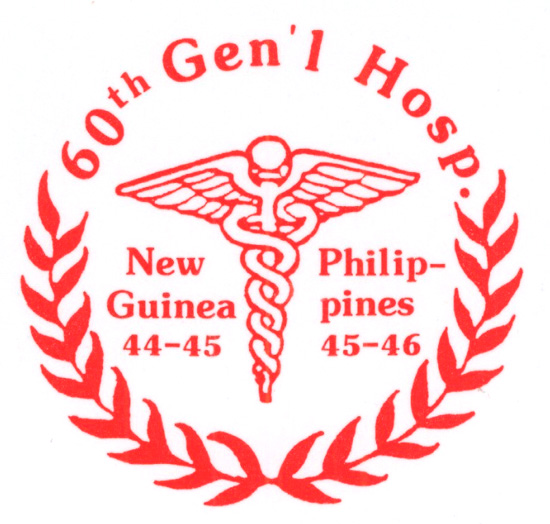
Partial view of Flyer cover prepared for the 3rd Reunion of the 60th General Hospital, held at Santa Fe, New Mexico, in 1988.
Introduction:
My name is Mary Helen Jost. I was born January 27, 1920 at the West Suburban Hospital, Oak Park, Cook County, Illinois, to Alfred E. Jost and Helen C. Hoffmann. Following 8 years of Grammar School, I graduated from York County High School after majoring in Science in 1938. I then entered the University of Illinois where I took a major in Physical Education, graduating the following year, i.e. in 1939. Having decided to go into nursing, I enrolled at the West Suburban Hospital School of Nursing where I remained for a period of 3 years, graduating as a Registered Nurse in 1942.

Portrait of Second Lieutenant Mary Helen Jost, ANC, N-771120, taken early 1942, while training with the Army Air Forces.
There was always a demand for RN, which allowed me to look for a job in this area of occupation, following which I was successfully employed as a Registered Nurse from 21 September 1942 until 4 January 1943. Since our country was at war now, I decided, after some initial hesitation, yet following so many others who volunteered, to join the Army Nurse Corps Reserve. Before however being able to assume an official role in the Army Nurse Corps, I had in accordance with my desire requested to enrol as a Reserve Nurse while expressing my desire for extended active duty with the Army of the United States. I received confirmation of my registration as an Army Reserve Nurse by official letter ref. AG 201-Warning Letter, issued by Headquarters, Sixth Corps Area, Office of The Surgeon, U.S. Post Office Building, Chicago, Illinois, dated December 30, 1942. I was further informed that the present plans contemplated that I would be ordered to duty on or about January 6, 1943, and would then have to report at either Station Hospital, Chicago Schools, Army Air Force Technical Training Command, 1660 Hyde Park, Chicago, Illinois (formerly Chicago Beach Hotel –ed) or at the Station Hospital, Truax Army Air Field, Madison, Wisconsin (activated in June 1942 –ed).
After passing the necessary tests and physical, I entered into service with the Army of the United States, being appointed a Second Lieutenant in the Army Nurse Corps, with Army Serial Number N-771120, on January 6, 1943.
Training & Assignment:
Not requiring nursing training (already being a RN), I went through general Basic Training (learning much more about the Army) and first became a General Duty Nurse (MOS 3449) being appointed July 30, 1943, eventually evolving to General Duty Nurse, Surgical Ward (MOS 3449-8) a position to which I was appointed September 19, 1944. I would serve as a General Duty Nurse for a total of 28½ months. My promotion to First Lieutenant came through on September 19, 1944.

Copy of Shipping Ticket dated 22 December 1943, detailing the mandatory allowances (individual equipment pertaining to T/E 21) received by Second Lieutenant Mary H. Jost, after being assigned to the 60th General Hospital.
After joining the 60th General Hospital at Camp Ellis, Table Grove, Illinois (Army Service Forces Training Center; total acreage 17,503; troop capacity 1,795 Officers and 24,654 Enlisted Men –ed), in west-central Illinois, where the first members of the personnel reported on May 25, 1943, the organization under the command of Colonel William A. Todd, Jr., MC and Major Max E. Klein, MC, Executive Officer, moved to El Paso, Texas, to complete its training before staging for a possible mission overseas.
Personnel Strength – 60th General Hospital (1944)
57 Officers
1 Warrant Officer
105 Nurses, Physiotherapists, Hospital Dietitians
5 American Red Cross workers
500 Enlisted Men
(FM 101-10 dated July 10, 1944 states that as per T/O & E 8-550 issued July 3, 1944 the following authorized strength applying to a 1,000-bed General Hospital was: 55 Officers – 1 Warrant Officer – 83 Nurses and other Specialists, and 450 Enlisted Men –ed).
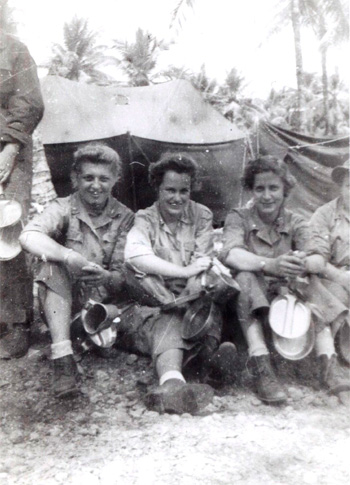
Some Nurses belonging to the 60th General Hospital are waiting for chow …
Initial activities included performing general nursing duties on the Medical Orthopedic and Surgical Wards of both Station and General Hospitals located in the Zone of Interior for approximately 8 months. I also acted as Chief Nurse for 1½ months and Assistant Chief Nurse for a period of 4 months in a Station Hospital in the continental United States. Apart from the nursing activities, I additionally performed administrative duties in the office of the above hospitals. I later worked as Head Nurse on the Neuro-Surgical and Genito-Urinary Wards of the 60th General Hospital on various islands and locations in the South Pacific Area. The patients receiving my attention included numerous battle casualties and personnel assigned to permanent bases in the Theater. I became a Surgical Supervisor during the siege of Manila, in the Philippines, and supervised the Nurses working on all Surgical Wards. My main duty as Head Nurse included setting up rosters, allocating work to the other Nurses, and supervising their duties and performance. For 2 months I was responsible for the set up and operation of the Dispensary of the Replacement Pool in the Pacific Area.
Preparation for Overseas Movement:
I remember that, prior to shipping out overseas, I had to follow a course on Malaria Training Control which was successfully completed February 19, 1944. This should have given us a hint as to our future destination. It however remained uncertain, as malaria could be encountered in Africa as well as in Asia and the Pacific…
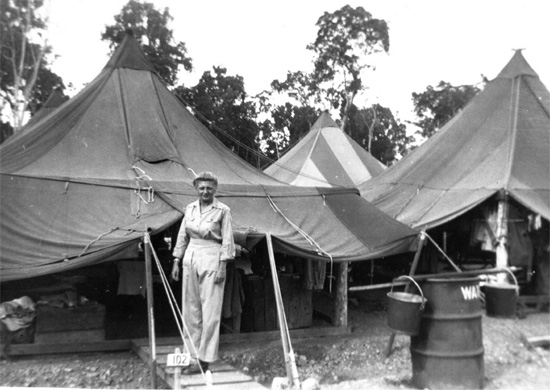
Picture illustrating Second Lieutenant Mary H. Jost in front of one of the M-1934 pyramidal tents, temporarily used for quarters, prior to moving into prefab hutments.
During the last part of December 1943, the ANC Officers were issued the necessary articles as based on T/E No. 21, dated June 17, 1943. After finishing packing, everyone was ready for entraining and conducting a cross- country ride to the San Francisco Port of Embarkation, in California. Upon arrival the staff and personnel re-assembled and staged at San Francisco POE, and after due processing embarked on USAT “Monterey” (AP-68) for an unknown destination. The date was March 8, 1944. The unit arrived in Milne Bay, New Guinea, Friday, March 24, 1944.
New Guinea:
The 60th General Hospital arrived in Milne Bay, New Guinea, on March 24 and disembarked Saturday, March 25, 1944. Upon disembarking, our detachment of Nurses moved to the Nurses’ Staging Area No. 2, located at the site of the 141st Station Hospital. The ARC workers were sent to the American Red Cross compound, while the Officers and Enlisted Men staged at the 5th Marine Regiment area. After three days to become oriented and set the area in order, the unit was requested to furnish work details comprising up to 60% of its available personnel for various duties on the base. The result was that several details, numbering up to 100 men each were assigned daily. The work consisted mainly of construction work on warehouses, theaters, hospitals, dispensaries, port infrastructure, quartermaster operations, medical depots, etc. This was customary for the Theater. Because of long supply lines, material shortages, and severe tropical rains, construction was slow, and medical personnel were often obliged to do most of their construction work themselves lacking the assistance from the already overburdened Army Engineers whose first priority was airfield construction. Throughout New Guinea, professional medical staff operated concrete mixers and bulldozers and enlisted personnel hammered and sawed performing as carpenters. By the end of March 1944, with malaria epidemics in full swing, only 1,630 hospital beds for almost 90,000 troops were available. Fortunately expansion gradually took place, and by June-July 1944, 3 General – 5 Station – and 2 Field Hospitals arrived in the area to bolster overall bed strength.

Typical view of an Admission Ward as constructed and in use in New Guinea.
Papua New Guinea Bases in Netherlands East Indies (1944)
Milne Bay > Base “A”
Oro Bay > Base “B”
Goodenough Island > Base “C”
Port Moresby > Base “D”
Lae > Base “E”
Finschhafen > Base “F”
Hollandia > Base “G”
Biak Island > Base “H”
On April 17, 1944, approximately 50% of the 60th General Hospital, exclusive of the ANC Officers, embarked on the AHS “Tasman” (ex-KPM vessel, later Dutch transport ship, converted into a Hospital Ship in Melbourne, Australia, in June 1943, designated Hospital Ship No. 5 –ed) for APO # 322. The advance party was led by Colonel Wm A. Todd, leaving the rear party under the command of Major Max E. Klein. A storm, said to be unusual for the area gave the rear group a couple of hectic nights, with high winds and heavy rains striking the area. Trees crashed and tents were blown away and damaged. Four (4) Officers and 2 Enlisted Men were sent to the hospital as a result of injuries, including minor cuts and bruises. Waiting for the storm to subside, the Rear Echelon commanded by the XO was marking time, waiting to join the remainder of the unit, in order to set up the hospital, and to begin functioning.
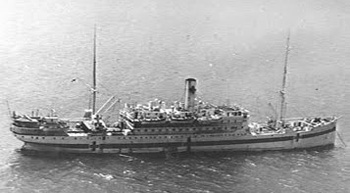
Picture of Australian Hospital Ship “Tasman” (operated by Dutch Officers and Javanese crew, and a mixed Allied medical complement) which carried the greater part of the 60th General Hospital personnel from Milne Bay to Finschhafen, New Guinea, in April 1944.
Starting May 1, 1944, the organization was now constituted as a Third Rear Echelon, made up of 3 Officers and 79 EM. In addition, the Nurses and Red Cross workers still remained at the base (Milne Bay –ed) APO # 928, until such time that the new site at APO # 322 would be ready. On May 7 the Second Echelon, consisting of 19 Officers and 181 Enlisted Men, under Lt. Colonel Leon M. Stern, DC, departed for Base “F” (Finschhafen) traveling on board the Australian Hospital Ship “Tasman”. Major Max Klein remained in command of the Third Echelon. About May 10, 1944, we were transferred to the Nurses’ Staging Area No. 1, moving into new quarters. At the same time 17 of us were placed on DS with the 17th Station Hospital. The main function of the Rear Echelon was to complete preparation of the equipment necessary to fully equip the 60th General Hospital. As soon as this was accomplished, the entire group would move and set up the main unit at Base “F” as expected. May 25, 1944 was a special day as it marked the first anniversary of our unit. This called for some celebration and a special dinner was prepared with the Nurses as the guests of honor! On May 30, 1944, 1 Officer accompanied by 11 EM of the 35th General Hospital, acting as supply guards, were attached to our unit for rations, administration, and duty. They were also awaiting transportation to their destination.
June 1944 started with the Third Rear Echelon now consisting of 1 Officer and 76 EM (supplemented by the attached contingent of 1 Officer + 11 Enlisted Men from the 35th Gen Hosp –ed) still remaining at APO # 928, together with the ARC workers and about 60% of the Nurses. There was now very little activity other than paperwork and administrative duties, except for approximately 40% of the men busy with work details for the special service, the signal depot, and the 96th Station Hospital, with general construction. Ten (10) of the Medical Technicians, had meanwhile been sent on special duty with the 227th Station Hospital at APO # 928, and 47 of our Nurses were serving on detached service at various hospitals located throughout Base “F”.

First Lieutenant Mary H. Jost (at right) and fellow Nurse, ready to move into new and more comfortable quarters, Australian prefabricated buildings.
June 12, 1944, the remaining cargo was finally loaded aboard the Liberty Ship “John M. Clayton” (later damaged and set on fire by Jap plane off Mindoro, January 1, 1945 –ed) and on June 15, Major Max E. Klein (XO), accompanied by 1 Officer and 3 Enlisted Men boarded the ship with destination Base “F”. First Lieutenant Howard A. Barton, MAC, was in command of the remaining personnel at APO # 928, Milne Bay.
Operations:
Base “F” – Northeast New Guinea
The 60th General Hospital was formally opened at 1930 hours with receipt of the first patient on July 18, 1944. It now operated at Base “F”, APO # 322, Finschhafen, Northeast New Guinea. Since the opening, the total number of patients admitted had been 2,101 and the patients evacuated 530. This included the period from July 18, 1945 up to February 21, 1945. Our total bed capacity was 1,064, with 597 patients set up in Australian prefabricated buildings and 467 housed in tents. Bed status was currently 959 with patients broken down as follows: medical – 565; surgical – 198; and neuro-psychiatric – 196. The majority of cases with psychosis were usually evacuated by air from forward areas (to other areas, or to Australia –ed) and were caused by prolonged residence in the jungle, actual battle experience, witnessing the death of buddies, and Japanese ferocity and cannibalism. A good number of patients suffered from eczema and infection and penicillin and sulfonamides were extensively used for therapy. Heat and high humidity in this climate tended to have a lethargic effect on personnel. Metal rusted more quickly than ordinary, wood warped easier, and clothing if allowed to remain in one position for any length of time began to mildew, rotting away.

Primitive living conditions in the field: three Nurses of the 60th General Hospital wash some personal clothing in their helmets.
The training of our unit consisted of prescribed monthly lectures on Malaria Control, Safeguarding Military Information, and Tropical Medicine. A weekly orientation program relating to the country and its environment were held with a 85% attendance. At the date of its opening, the unit was still 17 Enlisted Men short, with one Dental Officer over strength and 2 MAC Officers missing.
Overall sanitation of the new base area was satisfactory; water was pumped through underground water lines; and auxiliary tanks were kept filled in case of shortage or emergency. The only prevalent disease bearing insects were the mosquitoes, the control of which was prescribed in the Malaria Control Methods, for which I followed a program of lectures prior to leaving the Zone of Interior. Liquid wastes were disposed of by the use of soakage pits, other wastes were incinerated while solid ones were taken to the nearby pier and carried out to be dumped into the bay. Human excrements were evacuated by means of suitable sewage methods and emptied at sea (this did away with the initial deep-pit latrines, although scattered ones were kept in case of emergency).
While male Officers and Enlisted Men were currently housed in pyramidal tents, the Nurses were quartered in prefab Australian buildings, which also contained some of the wards and storage facilities. Construction was commenced on a 500-bed unit in Australian prefabricated buildings. The entire area and buildings were conveniently supplied by four (4) 30 KVA Ready Power generators; providing 127-220 volts.
Luzon – Philippines
The reason for attacking Luzon (after successfully invading Leyte and liberating it from the enemy –ed) was that Lingayen Gulf, where the Japanese had landed in 1941, not only offered excellent beaches, but furthermore gave ready access to the Central Plains at whose southern end lay the Capital City of Manila.
Our organization left Hollandia, New Guinea February 21, 1945 for the Philippines. The new destination was Luzon where we arrived March 2, 1945. The selected new installation site was to be Manila, Capital of the Philippines which became a unique experience for the staff and personnel of the 60th General. The unit almost entered Manila on the heels of the Japanese and was therefore closer to the enemy than was strictly comfortable. While US forces entered Manila as early as February 4, liberating over 1,200 captives, whole sections of the city were ablaze. The arrival of several hospitals, such as the 21st Station Hospital – 41st Field Hospital – 227th Station Hospital – 49th General Hospital and the 60th General Hospital during February and March 1944 signaled a new stage in the treatment of the numerous casualties in Manila, where the end of the battle initiated the transformation of a devastated city from battleground to a new base.
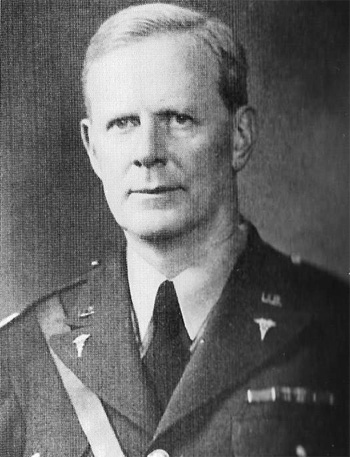
Picture of Colonel Maurice C. Pincoffs, MC (ex-CO 42d General Hospital, serving in the Pacific since 1942). The Officer was instrumental in creating a new Department of Health and Welfare in the devastated Capital City Manila, in the Philippines, which helped stabilize and restore a centralized medical organization after the fighting.
As far as ‘special’ clothing was concerned, it should be noted that ANC personnel received some allowances as prescribed for issue in Theaters of Operations, Tropical Zone. Among the mandatory allowances were such clothing items as summer slacks – women’s sweaters – women’s herringbone twill trousers, and some discretionary allowances including mosquito gloves and headnets. Moreover Nurses (as well as Physical Therapists and Hospital Dietitians) were encouraged to acquire mandatory purchases including seersucker shirts, skirts, and slacks, in fact more tropical clothing. Optional items as tropical worsted service clothing remained optional and was rarely worn in the field. Slacks were recommended and authorized for ANC personnel serving under WD overseas movement orders, as they were more comfortable to wear and offered better protection in the tropical environment.
After setting up, the medical and surgical services began functioning on April 2, 1945 admitting some 134 patients to its wards. Within only a few days, the patient census reached 760. It remained about the same level in April, but increased the following months. During the first week of activity and because of the shortage of surgical beds, such cases were admitted to the Medical Wards. Anyway, minor surgical conditions were cared for by the Medical Service whereas the most serious cases were treated by an Officer member of the Surgical Service. Later in the month, and thereafter, it was necessary for medical patients to overflow into the Surgical Wards.
Most incoming patients were American GIs, Philippine Scouts, Philippine Army personnel, and guerrillas. For the first part of April 1945, Filipino patients averaged approximately 10% of the total census.
During the initial part of operations on Luzon, the 60th General Hospital functioned more as an Evacuation Hospital; with patients generally received primarily from the combat areas. They would often come in only two (2) hours after being admitted to their Battalion Aid Station. The policy was to return to duty the mild acute illnesses and injuries and those suffering from combat exhaustion and shell concussions within a thirty-day period. A great many of these cases that should have been hospitalized less than 30 days after their diagnosis and initial treatment began, were transferred to another hospital in the area for convalescence. General Hospital cases and those patients requiring over thirty-days hospitalization were triaged, diagnosed and initial treatment started and then eventually transferred in conformance with Base “X” policy (Base “X” was established in Manila, within the Philippine Base Section organized by USASOS in 1945 –ed).
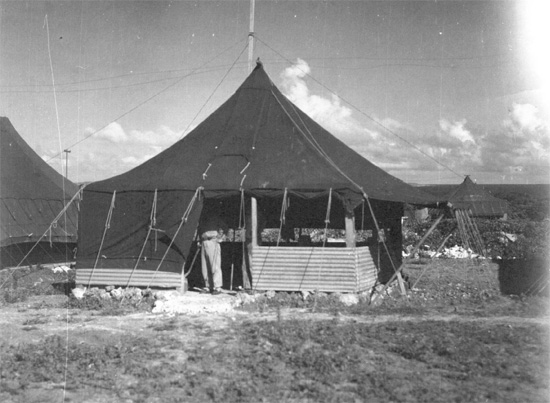
Typical view of M-1934 Pyramidal Tent used by personnel of the 60th General Hospital, with wooden floors and side panels, thus reinforced and protected against posssible rodents and unfavorable tropical weather conditions.
With fighting evolving to our advantage, working conditions improved and life in Manila became relatively safe. Notwithstanding the destruction and ruins, Manila would emerge as the prime source of supply, repair, and maintenance for all military equipment in the region.
In October 1945, the hospital stopped receiving patients and its personnel, for the most part, was alerted for return to the Zone of Interior (although some members went on for more hospital work in Japan after the enemy surrender –ed).
Departure for return to the United States took place on October 27, 1945 with the Officers and Enlisted Men reaching the Zone of Interior November 13, 1945.
Personnel Roster: (incomplete)
| Male Officers & Enlisted Men | Female Officers & Specialists |
| Accorti, Peter | Berretto Lodi |
| Army, Ernest J. | Boemke, Ruby |
| Arteberry, Francis | Block, Inky |
| Barton, Howard A. (1st Lt, MAC) | Blok, Peg A. |
| Bezenovich, Ned | Bottoms, Frances |
| Blake, Owen D. | Brown, Katherine |
| Bourne, Roger J. | Buckman, Helen |
| Buskirk, James H. | Burke, Carol |
| Clark, L. B. | Carlson, Marian |
| Clements, Vincent | Cashman, Colleen |
| Crawford, Robert | Chalker, Ann |
| Daly, John (Capt, ChC) | Chilson, Garland D. |
| Di’Arco, Mike | Cooper, Grances |
| Downs, Robert L. | Copeland, Doris |
| Elkins, O. W. | Cottet, Joyce |
| Finklestein, Howard D. | Cumming. Christine |
| Fiscus, Lloyd D. | Danion, Gertrude |
| Fluekiger, Howard J. | Dibernardi, Clara |
| Gaffey, Bernice | Diederick, Norma |
| Geisler, Joseph L. | Doehler, Elsie C. |
| Gilligan, Norman | Draper, Mildred |
| Gorr, Art | Dray, Anne |
| Green, Frank M. | Dvorak, Margaret |
| Grimes, Jim | Erwinger, Frances |
| Hamilton, Robert V. | Frank, Grace L. |
| Harmon, Roy C. | Frankwich, Claude |
| Haskins, Joe | Friedson, Pearl |
| Head, James R. | Fullenkamp, Edna |
| Hesselein, L. W. | Fusselman, Gladys (Col, ANC) |
| Hocevar, Ralph K. | Girard, Beatrice |
| Horst, Park | Gust, Bernadine |
| Ichniowski, Will | Hahne, Elaine |
| Ihde, Emil J. | Haynes, Dorothy |
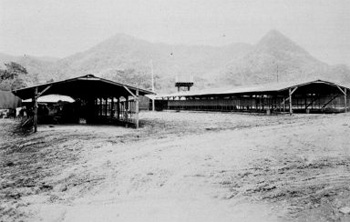
Distant view of the 47th Station Hospital buildings established at Milne Bay, New Guinea.
| Johnson, Harold A. | Hohmann, Irene |
| Jones Paul E. | Howard, Inez |
| Kearnes, Richard | Hrabsky, Nellie |
| Kemerer, James M; | Jost, Mary H. (1st Lt, ANC) |
| Kile, Robert L, Sr. | Kildebeck, Margaret |
| Klein, Max E. (Maj, MC) | Kline, Evelyn |
| Kudalis, Chester P. | Landreth, Evelyn |
| LaDuke, Cleon F. | Leeds, Sadie |
| Lauman, Clayton | Leighty, Mary K. |
| Long, James H. | Leuvick, Jennie |
| Longfellow, Art | Lissy, Ruth |
| Lynch, Robert J. (Tec 4) | Maltsberger, S. |
| Mercer, Lewis | Marinelle, Theresa |
| Miedusiewski, Frank | Martin, Rosabel |
| Migel, Dauchy | Mayer, Maryetta |
| Mizones, Stanley | McDermott, Frances |
| Moratz, Kenneth | McGirk, Marjorie (Lt Col, ANC) |
| Mosser, Leonard A. | Meier, Mildred |
| Murray, George A. | Mera, Pat A. (HD) |
| O’Dell, Martin | Miller, Faye |
| Papia, Steve | Miscavish, Ann |
| Patrick, James | Montgomery, Hazel |
| Percefull, Payne H. | Moore, Rita R. |
| Phelps, Lester R. | Nafziger, Ina |
| Piepenbrink, Wilbert | Noyes, Alice |
| Pierangelli, Phillip | Oliver, June |
| Pieti, Wilbert | Olkowski, Margaret |
| Piscitelli, Angelo | Olson, Mavis |
| Priselac, Joe | O’Neil, Gladys |
| Ramsey, F. G. | Paist, Pat T. |
| Raney, G. F. | Patrylo, Helen |
| Rifkin, Arthur | Quigley, Kathleen |
| Robertson, G. | Ragan, Angela L. |
| Roger, Ornin | Ray, Evelyn |
| Roseberry, Cullen | Redding, Margaret |
| Ruscitto, Julio | Ryan, Vi |
| Sandersfgield, Alfred | Schmetter, Mary |
| Schurtz, Miller | Schreiber, Alice L. |
| Sipes, Howard L. | Scott, Virginia |
| Slifer, Charles | Seppala, Miriam |
| Spitzer, H. R. | Seppala, Louise |
| Stern, Leon M. (Lt Col, DC) | Spark, Nettie |
| Stumbris, Edmund | Stolte, Mariann |
| Sullivan, Joe D. | Tompte, Bernice |
| Swift, Kevin | Trujillo, Georgia L. |
| Terminello, Fred | Vollmuth, Faye |
| Todd, William A., Jr. (Col, MC) | Wank, Elaine |
| Vogelsang, Milton | Wegman, Leona |
| Wallace, Marvin | Wilson, Charlotte |
| Ward, James J. (Tec 5) | Wright, Lorraine |
| Wick, Claude | |
| Wilkes, Al | |
| Wills, F. E. | |
| Willmoth, L. H. | |
| Wolven, James T. |
Decorations & Awards:
American Theater Campaign Ribbon (WD, dtd 1945)
Asiatic-Pacific Campaign Ribbon (WD, dtd 1945)
Philippines Liberation Ribbon with miniature bronze star (USAFFE, GO # 23, dtd 5 Feb 45)
New Guinea Campaign miniature bronze star (USAFFE, GO # 64, dtd 30 Mar 45)
Liberation Order Commonwealth of the Philippines Ribbon (USAFFE, dtd 21 May 45)
Luzon Campaign miniature bronze star (AFPAC, GO # 136, dtd 26 Aug 45)
Honorable Discharge:

Collage of pictures in memory of First Lieutenant Mary H. Jost, ANC, N-771120 who served with the Army Nurse Corps from 1943 to 1946.
First Lieutenant Mary H. Jost, N-771120, was Honorably Discharged February 14, 1946 at Fort Des Moines Separation Center, Iowa (Women’s Army Corps Replacement Training Center; total acreage 896; troop capacity 170 Officers and 7,845 Enlisted Men and Women-ed), after spending 1 year and 8 months in the Pacific Theater of Operations. Her ASR score at September 2, 1945, numbered 60 points. Lieutenant Jost was issued the traditional “Ruptured Duck” lapel button and momentarily sent home on leave. After serving in the Pacific Theater, she was transferred to Los Alamos, New Mexico (“Manhattan Project”, research and development project that produced the first A-bombs during World War Two; led by the United States with support of the United Kingdom and Canada; from 1942 to 1946 the project was under the direction of Major General Leslie R. Groves, Jr., CE, US Army –ed), where she met her future husband, Gerald E. Hower, a chemical metallurgist who worked at the Los Alamos National Laboratory on this ‘classified’ project. Lieutenant Jost was promoted to Captain in the AUS December 9, 1946, and passed away September 21, 2010.
Our heartfelt thanks to Jeff Hower, son of First Lieutenant Mary H. Jost, ANC (N-771120), who served with the 60th General Hospital in the Pacific Theater of Operations during World War Two. Jeff generously shared a lot of documents and photographs related to his Mother’s service years for which we are very grateful. The MRC staff are still looking for a complete personnel roster of the unit.
